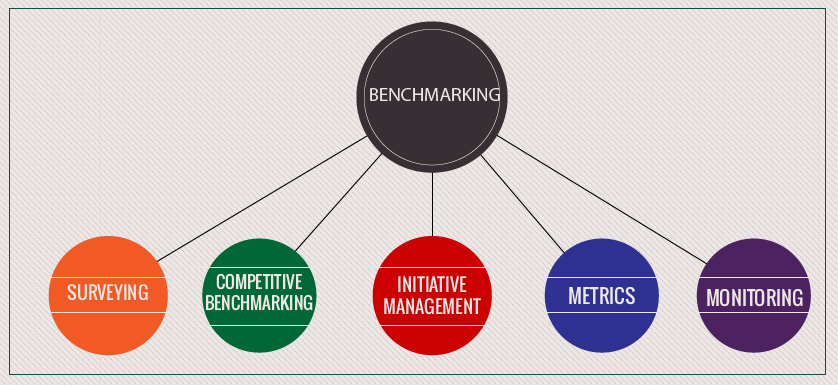
Benchmarking is a process of measuring the performance of a company’s products, services, or processes against those of another business considered to be the best in the industry. It’s known as the “best” in the industry. The point of benchmarking is to identify internal opportunities for improvement.
The term benchmarking was developed in industry in the early 1930s by Xerox. At this time, Xerox understood that Japanese competitors sold copy machines at a price that was well below Xerox’ production costs. As a result, Xerox conducted a market-related Benchmarking study (competitive Benchmarking) for its production department. The production costs, design and other attributes of all copy machines that were available on the market were studied and analysed.
This approach led to new, radical goals. Due to the success of the manufacturing department, Xerox conducted Benchmarking studies for all business areas in 1981. In the same year, the logistics and distribution departments conducted Benchmarking projects that incorporated all industries. Xeroz realised that benchmarking was also applicable to business processes outside the production department.
When organizations benchmark a practice of another competitive company it gives an edge that allows the organization to adapt, grow, and thrive through change. Benchmarking is the process of measuring key business metrics and practices and comparing them within business areas around the world to understand how and where an organization needs to change to improve performance. There are four main types of benchmarking: internal, external, performance, and practice.
Distribution and its costs are the crucial factors for the success of any FMCG firm which also needs to be focused on along with best price, best advertising, and highest margins of the product. Companies like Amul, HUL, Godrej, P&G, Nirma and Wipro have adopted to various strategies to strengthen their networks. But the distribution cost seems to be rising because of the vulnerability in logistics and rising of various issues related to distribution. Conventionally HUL had the best network, but Nirma adopted a great practice; it is the classic example of distribution efficiency. Nirma uses the direct method in which it supplies the products to the dealers directly from the plant unlinke the tradional FMCG setups using Clearing and Forwarding agents. Nirma thus created a practice benchmarking.
Performance Benchmarking
It involves gathering and comparing quantitative data (i.e., measures or key performance indicators). Performance benchmarking is usually the first step organizations take to identify performance gaps. For example, Amazon’s advertising strategy is very relevant. It advertises on Social Media Platforms offering a range of products and information to help the buyers choose from a wide array of products. Amazon Advertising is a pay-per-click model (PPC) that differs from some other marketplaces, e.g., Promoted Listings on eBay supports the PPS (pay-per-sale) funding model. There’s a relationship between ads and organic search on Amazon. Other e-commerce companies have started benchmarking Amazon’s advertising performance.
Practice Benchmarking
Thisinvolves gathering and comparing qualitative information about how an activity is conducted through people, processes, and technology. I have given example of Nirma’s direct method in which it supplies the products to the dealers directly from the plant unlike the traditional FMCG set ups using Clearing & Forwarding agents. Thus, Nirma created a practice Benchmarking.
Internal benchmarking: This compares metrics (performance benchmarking) and/or practices (practice benchmarking) from different units, product lines, departments, programs, geographies, etc., within the organization. ITC has changed its distribution supply chain model for cigarettes and packaged goods such as shampoo and soap to sharpen its competitive edge and reduce costs. Because of ITC’s core business of cigarettes, it has one of the most extensive distribution networks in India. ITC therefore can use factory-to-retail point distribution easily.
External benchmarking
It compares metrics and/or practices of one organization to one or many others. External benchmarking gives realistic view of a business in the race to succeed. One of the world’s largest consumer goods companies is Procter & Gamble, which operates in almost every country in the world with a variety of popular brands. But it’s not the only company that is trying to race to the top of the consumer goods industry. Read on to learn more about the company as well as its main competitors. Major competitors for P&G include Colgate-Palmolive, HUL, Nirma, Marico some local brands like Ghadi Detergent, Sasa Detergent etc.
P & G realized that compared with other categories within home care, laundry care has the highest penetration rate. With increasing penetration of washing machines and rising number of women in the workforce, consumers are looking for faster methods of washing clothes. Therefore, Procter and Gamble Company’s Indian unit started to manufacture Indian goods locally, the retail giant, who holds second position to Hindustan Unilever in the Indian market, followed the forerunner HUL’s style that will not only save cost but will also be more readily accepted by the Indian consumers. Through this practice, P&G will be able to produce goods at a lower cost and sell them to the Indian mass at an affordable price.
Conclusion
Ultimately, benchmarking is about being humble enough to admit that others are better at something. We never gain knowledge if we don’t look at the world beyond our own sphere. In the words of Peter Drucker, “What a business needs most for its decisions—especially its strategic ones are data about what goes on outside it. Only outside a business are there results, opportunities, and threats.”













































